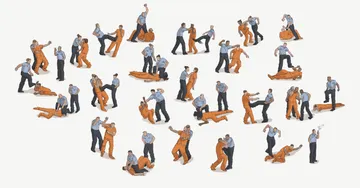In June 2008, a man wearing sunglasses and a baseball cap entered a 7-Eleven store in Killeen, Texas, pointed a gun at the clerk, and demanded money. A string of similar robberies had taken place at stores in the area, which is near Fort Hood, and police suspected they were all the work of one man. This time, they got lucky: a surveillance camera captured the robber as he fled the scene. They put the video on the evening news, and a phone tip led them to George Powell III.
The clerk had initially told police the robber was around 5 feet 6 inches tall, but faced with a photo lineup, she pointed to Powell. He stands 6 feet 3 inches.
At trial, there was strong evidence in both directions — other clerks in the area said they weren’t sure Powell was the one who had robbed them, while a jailhouse informant said Powell had confessed to him — but the height discrepancy was a key challenge for prosecutors. Their solution was to call Michael Knox to the stand.
A former Florida police officer, Knox told the jurors that he had studied a still image from the surveillance footage using photogrammetry, the science of making determinations about objects in an environment based on visual evidence, which is commonly used to create maps and virtual reality environments. Knox examined measurements of the store’s doorway and estimated that the robber was at least 6 feet 1 inch.
Powell, 43, was convicted and is currently serving a 28-year sentence. But last month, Mike Ware, executive director of the Innocence Project of Texas, filed an appeal claiming Powell is innocent and was wrongly convicted in part because of flaws in Knox’s work. Ware’s arguments are bolstered by an April 2016 report by the Texas Forensic Science Commission, which uses Powell’s case to raise questions about the overall consistency and reliability of video analysis.
Though the commission has no power to overturn a conviction, its investigations have marshalled legal and political scrutiny around forensic sciences from DNA to bite marks to arson. The report suggests forensic video analysis may join that list. The tools are not new. Photogrammetry traces its origins to Leonardo da Vinci’s 15th century work on perspective. Abraham Zapruder’s 1963 amateur video, capturing the assassination of John F. Kennedy, was picked apart by dozens of agencies, commissions, and individual citizens. But in recent years, many judges have been tasked with deciding whether an individual analyst’s work is credible enough to go before a jury. As more businesses install security cameras, police don body cameras, and cell phone users post videos of nearly everything, disputes over how such recordings are handled and analyzed are more likely to arise.
After he was convicted, Powell began corresponding with Tamara Parsons, a criminal justice student in Canada. Eventually, they fell in love and she moved down to Texas. She read the trial transcript and was suspicious of Knox’s analysis. “It didn’t feel like in his testimony he knew what was going on,” she said. She convinced Powell’s family to hire Al Yonovitz and Herbert Joe, who examined the video and determined that the robber was actually 5 feet 7.5 inches, with a half-inch margin of error, which would clearly rule out Powell.
Parsons also submitted the case to the commission, which hired a new analyst, Grant Fredericks, who has taught video analysis at the F.B.I. National Academy in Quantico, Va. He concluded that the suspect in the video was between 5 feet 5.8 inches and 5 feet 9.4 inches, and wrote in a report that “Mr. Knox failed to follow industry accepted standards and methodologies in the execution of his photogrammetric examination.”
Knox used only one image, Fredericks wrote, when he should have used many, and measured the robber’s height with a curved line along his body, as opposed to a straight line from the top of his head to the ground. “The combined errors of Knox’s work added approximately 5.5” to his height analysis,” Fredericks concluded.
In the meantime, Knox revisited his findings, using new photos of the scene, and said the robber was in fact at least 5 feet 10.4 inches. Knox defends his work, saying Fredericks’ analysis “comes off as a bit of Monday-morning quarterbacking.” There are multiple techniques used in photogrammetry, and Knox says his technique of making measurements is more objective than Fredericks’ method of “reverse projection,” which involves overlaying the original image on a new image of the scene. Other analysts back Fredericks as a leader in the field and “reverse projection” as a long-standing and well-established methodology.
But beyond the particular disputes over Powell’s case, the commission’s report concludes that there are pressing questions about how to establish whether an analyst’s work is reliable, and that there is “an urgent need for more publicly accessible information” regarding professional standards.
The report “encourages the criminal justice community” — district attorneys, judges, defense attorneys, and others — to work more closely with the Law Enforcement and Emergency Services Video Association, which certifies analysts only after they complete 288 hours of coursework and defend their work in a case before a board. Knox was not certified by the group.
George Reis, a certified analyst in California, says his fellow analysts agree that their science is valid and reliable when it’s done well, but that judges tend to be too permissive in terms of who they let testify. “The problem is that judges don’t want to exclude experts,” he says. The commission report, and the results of Powell’s case, will likely cause judges to examine the credentials of analysts more closely, at least in Texas.
A state district court will soon rule on whether Powell is entitled to relief. That recommendation will be sent to the state’s Court of Criminal Appeals, which will have the ultimate decision on whether to overturn his sentence.
